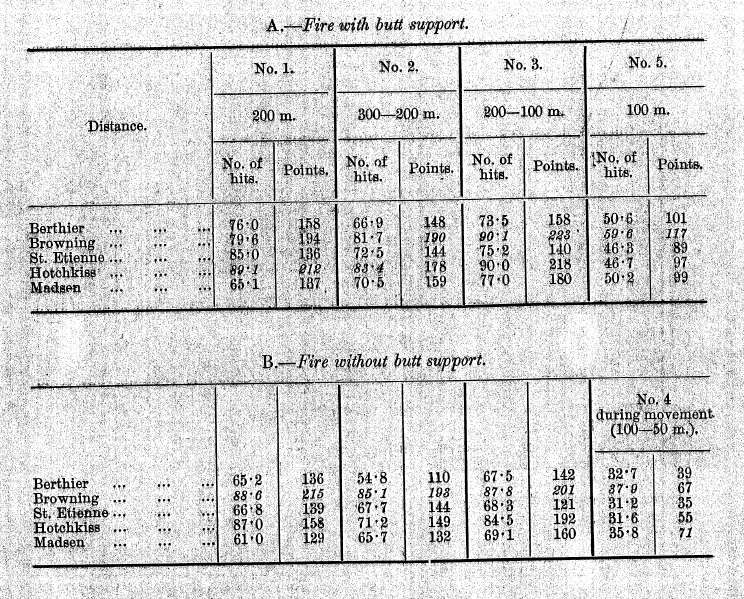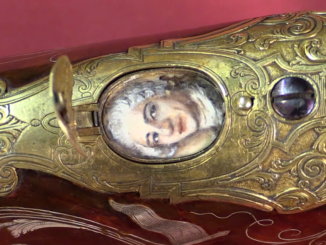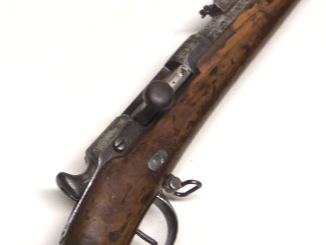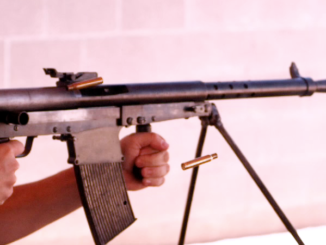In 1923, the French military held a light machine gun trial to choose a weapon to replace the CSRG Chauchat. The trials involved weapons evaluations both by an expert committee and by 9 regiments testing the guns in field conditions. The guns submitted for testing were:
- Browning BAR
- St Etienne (we are not sure which model this was, but clearly not the 1907)
- Vickers-Berthier
- Hotchkiss, strip-fed
- Hotchkiss, magazine fed
- Madsen
The Lewis and Darne guns were intended to be tested as well, but the sample guns were not received in time. You can see the complete results of the testing by downloading the 1923 French LMG Trials Report (in English), but here are a few of the highlights:
Magazine feed was determined to be superior to belt or strip feed despite a lot of argument. The main reason was the protection magazines gave to cartridges, while belts and strips left the ammunition exposed. In addition, contrary to what later field experience would dictate, changeable barrels were considered a weakness. The added weight detracted from the amount of ammo that could be carried, and the test directors felt that barrel changing should not be necessary except in very extreme circumstances.
Vickers-Berthier
The Berthier design was initially liked for its simplicity and accuracy. However, it was found to be very malfunction prone when heated up or slightly dirty. Failures to feed properly accounted for up to 10% of cartridges in some tests.
Browning BAR
The BAR was very well received by those who shot it. The only major complaint was a lack of bolt hold-open and the amount of exposure to dirt from the open bolt when in use. The Browning had basically no malfunctions (other than a few directly attributable to faulty cartridges), and firers particularly like the smoothness of its operation.
St Etienne
The St Etienne design received mixed reports. Some said it was a very effective, accurate, and reliable weapon while others claimed is performed poorly on all accounts. This is most likely because the gun was not in mass production, and each example was hand fitted – some better than others. The St Etienne also suffered from a more easily plugged gas system than other guns, and it was noted in particular that is a gun was not cleaned when hot it could seize up and become inoperable when cooled.
Hotchkiss
The Hotchkiss was well liked and found quite accurate. Two models were tested; one with a belt/strip feed and one with magazines. The magazine was determined to be the preferable system, although the mag-fed Hotchkiss in the trials was still not fully developed and had some feed problems. A few other complaints were reported (the need for a handguard and ejection port buffer, for example), which were easily remedied.
Madsen
The Madsen was clearly a polarizing item of disagreement for those doing the testing. Some loved it and some hated it. Those who did not like it complained about the complicated mechanism, the potential for dangerous malfunctions (misfed cartridges are often in a position where they could be fired out of battery – we have seen these types of malfunction ourselves with 1940s model Madsen guns). Some also found the recoil action uncomfortable to shoot and disliked the possibility of a cartridge remaining in the feedway after removing the magazine. Those who like the gun praised its quick field-stripping, accuracy, reliability, and the incorporation of the feed lips into the gun itself (which prevents most magazine-related feed problems).

Conclusions – the Chatellerault
The Berthier and Madsen were eliminated from consideration, and the Browning was considered the trial winner by most of those involved (with the Hotchkiss coming in second place). However, these trials were being done while the French Chatellerault light machine gun was in final stages of development. It was tested late in 1923, and found to be mechanically the equal of the Browning while also being more ergonomic to use (easier magazine changes, simpler to disassemble, and easier to train gunners on). So despite the BAR’s winning performance, France went on to adopt the Chatellerault in 1924.
I have to agree with the testing in this case. The Chatellerault was a very good design, and it was a second generation light machine gun compared to all the other guns tested in this program. The Madsen, Hotchkiss, BAR, and others were first-generation designs with modifications to bring them more or less up to date. The 1920s and 30s would see the development of a new group of excellent light machine guns like the Chatellerault, ZB/Bren, and (to a lesser extent) DP. While we are very fond of the Madsen around here (and I like the Hotchkiss as well), I would choose the Chatellerault too if I knew I had to take the gun into combat.




Excellent analysis, Ian. I also agree with your conclusion. The DP was also an excellent design, especially some of the later, experimental versions from the late 30s that did away with the pan magazine. Unfortunately for the Soviet army, the basic DP was kept in production for the duration of the war.
The Madsen longevity is in itself an enigma, especially after the early 30s, when so many superior light machine gun designs were being produced and fielded. I have somewhere in my files a detailed acount of the trial held by the Brazilian army in the early 30s to select their new light machine gun. I will take a look at it, for it might be interesting to find out why did the Brazilians chose the Madsen over, for instance, the ZB-30. Brazil, together with Portugal, was a rather enthusiast user of the Danish gun for decades.
You got the wrong type of Hotchkiss LMG – newer „Hotchkiss fusil mitrailleur“ was tested for French trails, not the WW-1 era „Hotchkiss portative“
http://world.guns.ru/machine/fr/hotchkiss-m1922-e.html